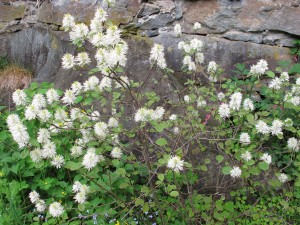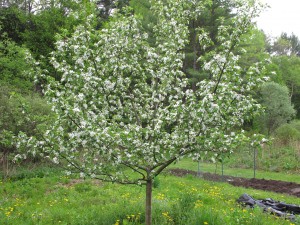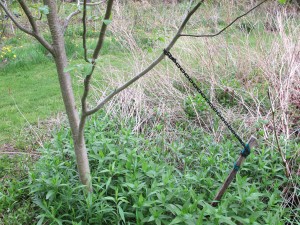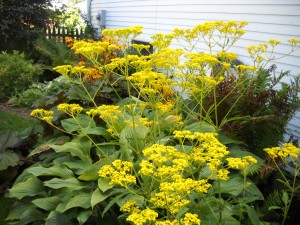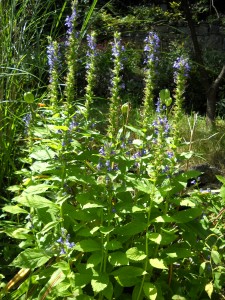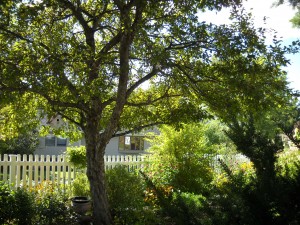Selecting and Training Flowering Trees
This has been a great year for flowering trees and shrubs. My Merrill magnolia had many hundreds of white blossoms in late April.
The crabapples everywhere put on a spectacular display this year. My fothergilla (a shrub with great fall leaf color) is in bloom now with its tidy white bottle-brush flowers. My ‘Olga Mezitt’ rhododendron (one of the parents of the popular PJM rhodie) is looking great and my wild azaleas are getting ready to bloom. And now the lilacs are blooming for me and I am overwhelmed with the large purple, blue, white and pink panicles (clusters of flowers). Spring has definitely sprung.
All these blooms this year will certainly encourage many gardeners to buy trees and shrubs and plant them. That’s a fine idea, but if you plant now, please remember that you must keep watering them all summer if we don’t get an inch or more of rain per week. When August comes around it will be easy to have your new tree dehydrate if you get lazy or forgetful.
New trees and shrubs need a year or more to grow roots sufficient for their needs if we get hot, dry weather. So if you are forgetful or will be doing lots of traveling, you might want to hold off on planting a new tree until fall, which is also a good time for planting. Fall is cooler and more likely to be rainy.
I like to buy flowering trees and shrubs when they’re in bloom. That allows me to see the color and check out the fragrance. But there is more than just the flowers to consider when selecting a good crabapple or magnolia. Let’s start with size and price. Bigger
is not necessarily better. If you are on life support and don’t expect to be around in 5 years, sure, buy the biggest tree you can afford. But be aware that a bigger tree is not only more expensive – it is also harder to plant and takes more water and care. A bigger tree may have a smaller proportion of its root system intact after being dug up and put in a pot than a small tree. I like to buy smaller specimens and then train them to be a nice shape. That’s harder to do on a larger tree.
I recently visited a nice new nursery run by Henderson’s Tree Service on Rte 14 in Hartford, Vermont. There I chatted with my friend Sylvia Provost who is co-owner of the business. I asked Sylvia what she would look for if purchasing a crabapple for herself. Without a moment’s hesitation she responded. “Structure,” she said.
What Sylvia was talking about is the shape of the tree and the placement of the branches. Fruit trees produce best on branches that leave the trunk at a right angle or are aiming just slightly upward. Branches that shoot straight up are not usually good fruit and blossom producers.
And although Sylvia noted that you can train a tree to be the shape you want, it is easier to start with something that is closer to your ideal before you start training. So, for example, Sylvia said that if you have a swimming pool some distance from your patio, you should choose a tree that has an open format, one that you can see through – and see what is happening at the pool. Conversely, if you have nosy neighbors and want to screen their view of your patio, you might select a tree that has a full, dense arrangement of branches.
Generally, pruning a tree should begin in the second year of its life at your home. I often see apple and crabapple trees that have very low branches. I like to prune off those low branches to make it easy to mow around, and to have a nicer look. And if two branches are both striving to be the “leader” or the dominant, tallest stem, I remove one. And although most books say you should prune fruit trees in March or April, you can safely make a few judicious cuts now to train your tree.
You may train branches to grow at different angles by weighing them down – if you do so soon. This is an activity for spring, starting before the new layer of cambium growth has occurred. You can drive a stake into the ground and tie a branch to it for the next 2 months. A branch the diameter of a finger can weighed down by hanging a plastic pop bottle on it, then filling it with water until it bends to the correct angle.
Chris Wilson of the EC Brown Nursery in Thetford, Vermont suggested that when buying a tree, look at leaf color – leaves should be green, not tinged with yellow. He also suggested making sure the tree has branches on all sides, and that the bark has not been damaged.
So if you’ve delighted in the flowers on trees in your neighborhood this year, go get one or more. Study several specimens to find the best one. And just remember to water all summer long!
Henry Homeyer is a gardener and garden designer living in Cornish flat, NH. His Web site is www.Gardening-Guy.com.
How Long Does it Take to Create a Mature Garden?
Several years ago I interviewed the late Tasha Tudor, the reclusive illustrator and author, at her garden in southern Vermont. One question I asked her was, “How long does it take to create a garden?” Her answer, as reported in my book Organic Gardening (not just) in the Northeast, was succinct. “It takes twelve years to make a garden. Everything takes time that’s worthwhile.” I find that fascinating in light of recent visits to the gardens of Susan Weeks, of Lebanon, NH. Her lovely mature gardens were started around the year 2000 – some 12 years ago. And although Susan says they are still a work in progress, hers would make most gardeners ready to sit back and just admire them.
Susan moved into her house in 1995 with the idea that it was her final move: “I knew this was going to be my last home – the canvas I was going to be working on for the next 40 years – or until they drag me out of here.” When she moved in, her landscape consisted of a modern white house on a green lawn with just a few trees – a small blue spruce, a white pine and a rug of juniper on either side of the front door. It took her awhile to decide what to do, but by 2002 she decided to start planting some trees.
Susan decided to spend her money on trees that were already of fair size – at least 2 inches in caliper (diameter). She knew that she could cut corners and buy from a big box store, but doesn’t think it makes sense to do so. “I believe in buying local. They (locals) know what works here. It might be more expensive, but it works out better for everyone,” she told me. Over a few years she had a crab apple, two sugar maples, a Japanese tree lilac and a Japanese red maple installed. She kept them watered, made sure the lawnmower stayed away, and now these trees provide shade and beauty.
A mature woman of relatively small stature, Susan knew that these trees would best be installed by someone else, so she hired E.C. Brown Nursery of Thetford, Vermont to supply the trees and plant them. “As you get older, if you have some heavy work that needs to be done, it makes sense to get somebody it to do it for you.” That allowed her to work on the perennial gardens that she has developed over the past 10 years.
Gardening should be fun, and should be consistent with a gardener’s value system. Susan has two adorable old dogs that have grown up in her gardens, and she decided from day one that no chemicals would be used in her gardens – she didn’t want to risk harming Zoe and Maggie, her dogs. She fenced in part of the yard so the dogs would have a nice place to lounge around, and trained them to respect the flower beds while allowing them places to dig holes to lie in on hot days. Over the years she has expanded the fencing 3 times (as her budget allowed, I suppose) and the 4-foot tall white picket fence now encloses just about all of her property. There is a buffer zone, also planted, between the fence and the street.
Susan started planting perennials, adding the more each year. She has plenty of common flowers: bee balm, hostas, daylilies, iris, and black-eyed Susans. But after awhile, she took a four-evening class on gardening and started to get more confidence. She craved more interesting and unusual plants.
She tried Canadian burnet (Sanguisorba canadensis), great blue lobelia and ligularia. She got things with no common name like Persicaria superbum. Right now she has a tall shade-loving plant with bright yellow flowers that I’d never seen before, one she got from Cider Hill Gardens in Windsor, Vermont. It’s a Patrinia (no common name) and it’s not clear if it is a P. triloba or a P. gibbosa. I must get one.
At some point Susan decided she needed a small water feature, and created a little pond about 8 feet long and 3 to 4 feet wide with a pump that shoots a gentle stream of water into the air. She dug the hole herself, lined it with a special rubber liner, and covered the edges with flat stones. “A weekend project,” she said. She put in goldfish – and moved them indoors each winter to keep them alive. She told me that the sound of the bubbler is good for attracting birds. She loves the birds – another good reason for using all organic products.
Over time Susan has introduced flowering shrubs to her landscape, saying that as one gets older it’s important to have lower-maintenance plants. She is moving away from perennials that need to be dug and divided on a regular basis. Among the shrubs she has planted are weigela, hydrangeas, lilacs, ninebark, fothergilla; blueberry (for fall foliage); beauty bush; viburnum, daphne, Clethra, butterfly bush and others. She has a dog-eared copy of Taylor’s Guide to Shrubs, and each time she plants a new shrub she ticks it off in the book and writes the date planted.
And although Susan says she is cutting back, slowing down, I noticed that she had just excavated a new bed outside her fence. And she is eyeing a bit of lawn by the street. “Grass – it’s just one big perennial. It’s okay to dig some up for other perennials.” I can’t wait to see what happens in her gardens after she retires from her job in a few years.
Henry Homeyer’s upcoming kid’s book, Wobar and the Quest for the Magic Calumet, will be on shelves in October.



